The Highlands are typified by awesome mountains, expansive sandy beaches and atmospheric moors but it’s not just the landscape that’s captivating: there’s malt whisky and haggis, rich cultural history, and fresh air to revive and invigorate everyone who visits.
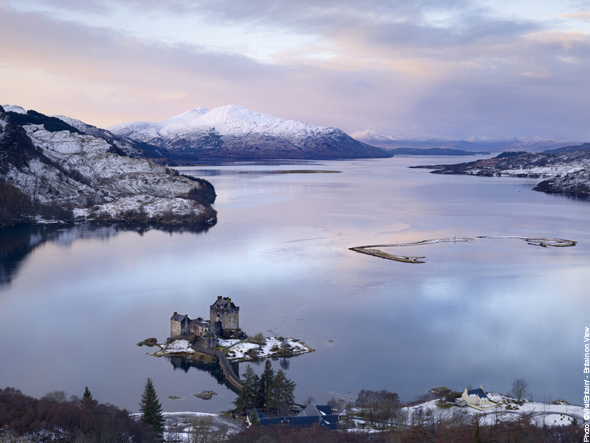
‘Wherever I wander, wherever I rove/The hills of the Highlands for ever I love,’ wrote Scottish poet Robert Burns in 1789.
Burns has a special place in every Scot’s heart and to mark the poet’s birthday on 25 January each year, Burns’s ‘Address to a Haggis’ is recited with flourish before dining on haggis, neeps and tatties. Burns’s love for the Highlands echo the sentiments of generations of writers and artists, visitors and residents, who have all been captivated by the region. Queen Victoria enthused, ‘There is a great peculiarity about the Highlands and Highlanders; and they are such a chivalrous, fine, active people,’ and proclaimed Balmoral Castle, where the current royal family still take holidays, to be ‘my dear paradise in the Highlands’.
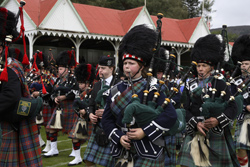 |
| Braemar Gathering |
It’s no wonder the clean air and wide vistas have produced such inspiration. This is a land of soaring mountain peaks and deep lochs, of rolling hills and isolated moorland – and famously wild weather. But it’s not always wild: look out across the golden sandy beaches on a cloudless day and you could be in the Caribbean, save for the temperature of the sea. The attraction here isn’t purely scenery. Ancient castles hold the key to enthralling and, occasionally, gruesome tales; crumbling crofts serve as a reminder of the Highland clearances that, writes Francis Pryor in The Making of the British Landscape, changed the rural landscape and its communities for ever. Scotland’s a gastronome’s dream: there’s fresh seafood, game and hundreds of malt whiskies in which to indulge. Plus there’s abundant wildlife; red deer, beavers, otters, golden eagles, whales and dolphins and the infamous Loch Ness monster.
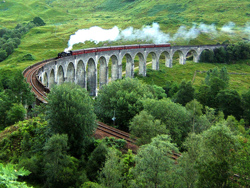 |
| Glenfinnan Viaduct, of Harry Potter fame |
The Highlands span a vast area. From Stirling in the south, traditionally regarded as the ‘gateway to the Highlands’, the region encompasses Loch Lomond, the Cairngorms National Park, Loch Ness and the city of Inverness, up to John O’Groats in the far north. The best way to appreciate this extensive area is to absorb its delights slowly. Several long-distance walking and cycling routes traverse mountain, moor and forest by means of dedicated trails. The West Highland Way, which runs from the outskirts of Glasgow to Fort William, passes the peaceful shores Loch Lomond and crosses desolate Rannoch Moor; the Great Glen Way is a gentle path linking Fort William and Inverness through woodland and along canals. Until the mid-19th century travel between towns and villages was largely via ancient cattle-droving roads; it wasn’t until the turn of the twentieth century, when most of Scotland’s railways had been constructed, that travel times reduced sufficiently to encourage tourism. The West Coast Line opened in 1894 and offers some of the finest views from a train window anywhere in Britain, surpassed only by the breathtaking journey from Fort William to Mallaig, made famous as the route taken by the Hogwarts Express in the Harry Potter movies. Driving in the Highlands is a pleasure. Though many roads are single tracks, there are rarely any traffic jams and views are magnificent.
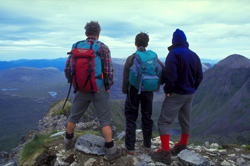 |
| Walkers in Torridon |
The western Highlands is particularly impressive. From the Applecross peninsula through Torridon to Durness and the remote and beautiful expanse of Cape Wrath on the north coast where Scotland meets the mighty Atlantic Ocean, rugged mountains rise majestically from the sea, deep lochs fill valleys, small burns trickle through the heather and roads wind their way up and down through the glaciated valleys passing pine forests and seashore sand dunes. There’s fascinating natural history: Knockan Crag boasts the most complex rock formation in north-west Europe. The story of its discovery begins more than a century ago when two Scottish geologists, Peach and Horne, were mapping the region. In a revolutionary theory published in the 1880s they suggested that the top layer of rock, the moine schist, was older than the rocks beneath and had been ‘thrust’ on top of the younger rock. At the time this was controversial, but modern geologists have proved their theory was correct. What’s become known as the Highlands Controversy is described in eloquent detail by Ian Vince in his 2010 book, ‘The Lie of the Land: An Under-the-Field Guide to the British Isles’.
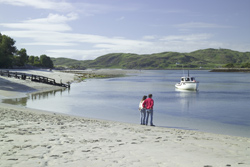 |
| Beachside on Loch Morar |
Each Highland village has a history. Ullapool, a small sheltered port on the shores of Loch Broom that’s popular as a holiday destination, was founded by the British Fisheries Society in 1788 to build up the herring fishing industry. The village itself was designed by Scottish civil engineer Thomas Telford (1757-1854), who also worked on St Katharine Docks in London. Though herring stocks had been depleted by the 1970s, the sea remains key to locals who make a living from salmon farming, crab and lobster fishing. Glencoe valley is peaceful and magical, though it wasn’t always so: here in 1692 a grisly battle between two clans, the Campbells and the MacDonalds, saw many die. These days the area is a magnet for anyone keen on mountaineering, hillwalking and trout fishing. The workaday town of Fort William is one of Scotland’s outdoor activities hubs, in part thanks to its easy accessibility (the West Highland Railway arrived in 1894) but also for its famed mountain; the town sits at the foot of Britain’s tallest mountain, Ben Nevis, which tops 4,406 feet (1,343 metres). On the first Saturday in September since 1899 there’s been a race to the summit: the fastest ascent on record was 1 hour 25 minutes by Kenny Stuart in 1984. The average round trip is much more leisurely; the majority of the 100,000 walkers who attempt the climb annually take around six hours there and back, usually via the ‘pony track’, which was constructed in 1883 to lead visitors to the now nonexistent summit observatory. A ‘wee dram’ in the town’s Grog and Gruel pub makes a rewarding post-climb treat. Glen Nevis was one of the film locations for 1995’s Oscar-winning film Braveheart, which retells the story of 13th-century Scottish rebel William Wallace who leads his compatriots in a battle against King Edward I of England.
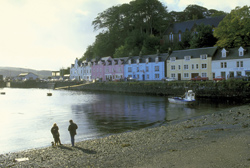 |
| Portree on Skye |
The Isle of Skye, accessed via the 1995-built Skye bridge, offers dramatic landscapes and, on a clear day, spectacular views to the Outer Hebrides. Bonnie Prince Charlie would have had a testing crossing; he fled here by boat in 1746 following his defeat at the Battle of Culloden, which took place near Inverness. The site of the bloody battle (the last on British soil), which saw more than 1,200 men die in one hour, has been restored. An exhibition by the National Trust for Scotland relates the events leading to the fateful day that saw the end to the Jacobite rising against British rule. For modern day walkers and climbers the lure is the challenging route across the Skye Cuillin ridge, though the rock formations on the Trotternish peninsula – the gravity-defying Old Man of Storr and the otherworldly pinnacles and buttresses of the Quiraing – are equally striking and more accessible.
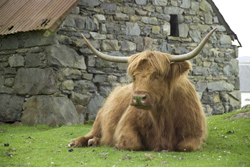 |
| Highland cattle |
The rolling hills of the north-east Highlands are in bold contrast to the dramatic peaks of the west, but this restful region has its charms and received a royal seal of approval by the late Queen Elizabeth, the Queen Mother, who bought the Castle of Mey in 1952 and spent holidays here. But it’s not only castles, Bronze Age and Iron Age ruins pepper the Highlands. Scotland’s northernmost town is Thurso, which derives its name from the Old Norse ‘Thors-a’ meaning Thors river. In common with other coastal settlements, the sea has been important in Thurso’s development: the Vikings arrived by boat; in the 17th and 18th centuries, beef and fish were exported; in the 19th century, fortunes were made shipping paving slabs across the world.
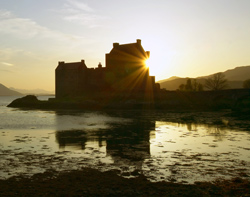
The northernmost point of the British mainland isn’t, as is commonly mistaken, John O’Groats, but windswept Dunnet Head, where a grand lighthouse stands firm facing the waters of Scapa Flow and the Orkney Islands. The 27-hectare site is managed by the RSPB and is a haven for seabirds such as puffins, guillemots and kittiwakes, which soar above abandoned wartime huts – Dunnet Head was used by the Navy and Royal Air Force as a lookout during the Second World War.
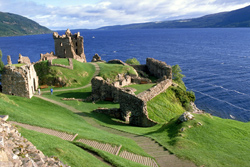 |
| Urquhart Castle |
The Highlands are sparsely populated. Inverness, the main centre, is a compact and friendly city of around 80,000 residents. Local resident Clem Fisher was born and bred nearby. ‘Cromarty’s maritime trade flourished in the eighteenth century. Large houses were built by successful merchants to blend in with the smaller existing cottages of the fisher folk. Moving swiftly ahead from those early days, the Cromarty Firth was the site of a very active oil rig platform construction yard in the 1970’s and 1980’s, with vast structures being floated out to the northern North Sea. Since the 1990’s cruise liner activity using the port of Invergordon has increased rapidly, generating a great deal of business for local traders.’
Inverness-shire also claims grand literary associations – it was here that Shakespeare set ‘Macbeth’, where the sometime Thane of Cawdor and, briefly, King of Scotland, met his tragic end. Shakespeare never visited Scotland but wander through Cawdor Castle and you can almost hear the witches proclaiming ‘Double, double toil and trouble/Fire burn, and caldron bubble’.
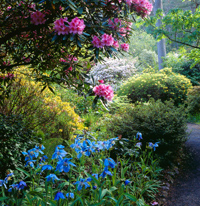 |
| Inverewe Gardens |
The Cairngorms is Britain’s biggest national park and features ancient forests, rushing rivers and small villages interspersed with awe-inspiring hills. This wilderness covers 1,467 square miles (3,800 square kilometers) and is more than 1,968 feet (600m) above sea level; the plateau is even higher, at 3,936 feet (1,200m). The region’s weather is the most extreme in Britain, and in the winter months temperatures in the lower glens ranges from several degrees below freezing to around 5C. Snow sometimes lingers into the summer; in 2010 more than 100 skiers enjoyed a session on the slopes on midsummer’s day. This Arctic tundra landscape might be exposed and unforgiving, but it’s also beautiful and teeming with wildlife including reindeer, red squirrels and the timid mountain hare. Birds include ptarmigan (whose feathers turn white in winter to blend in with the snow), ospreys and golden eagles.
If you’re in Scotland on 25 January, remember to toast the haggis and recite Burns. But even if you can’t be there for Burns’ Night, there’s no finer excuse to enjoy a wee dram, raise a glass to Burns and pledge to return soon to the Highlands and its unforgettable charms.
Further information
Visiting the Highlands
For further information on where to stay go to www.visitscotland.com and (for readers in North America) www.cometoscotland.com. To order a brochure ring 0845 22 55 121. Tourist Information Centres: Castle Wynd, Inverness, Inverness-shire IV2 3BJ; tel: 08452 255121; 15 High Street, Fort William, Lochaber PH33 6DH; tel: 0845 2255121.
If calling from overseas, dial your
international code, then 44, and drop the first zero.
How to get there:
Flybe flies from London Gatwick to Inverness seven days per week. For the full timetable see the website. Tickets are on sale from £35.99 one way, including taxes and charges. Tel: 0871 700 2000; www.flybe.com
Places to to stay in the Highlands
The Drumossie Hotel (4-star): Inverness. A comfortable base from which to explore Inverness and the Highlands. It’s boasts a peaceful location in nine acres of parkland three miles from Inverness city centre. The fine dining restaurant serves a la carte dinners. Breakfast options include kippers, scrambled eggs with smoked salmon or a traditional full Scottish. Tel: 0844 8799017; www.drumossiehotel.co.uk
Ardvreck House (4-star): Ullapool, Ross-Shire. This spacious ten-room B&B with en-suite rooms and tea and coffee-making facilities is run by friendly hosts Evelyn and Duncan and enjoys a peaceful rural setting with spectacular views of Loch Broom and Ullapool. Tel: (01854) 612028; www.smoothhound.co.uk/hotels/ardvreck
Pentland Lodge House Hotel (4-star): Thurso, Caithness. Good sized rooms with contemporary decor and modern facilities, including tea and coffee-making facilities and off-road parking. The listed building is within easy walking distance of the main town; some rooms boast spectacular views over Thurso Bay. Tel: (01847) 895103; www.pentlandlodgehouse.co.uk
If calling from overseas, dial your international code, then 44, and drop the first zero.
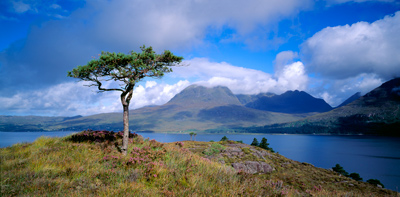 |
| Inverewe Gardens |





 © 2024
© 2024